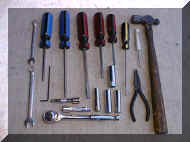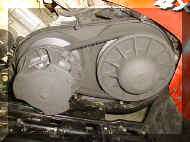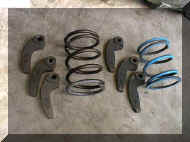Hot Seats Hypershift clutch kit
| Hot Seat’s Hypershift Clutch Kit |
 |
 Proper CVT (continuously variable transmission) set-up is one of the most important factors in keeping the machine running at peak performance level at all times. Hot Seat offers a Hypershift clutch kit for Polaris ATVs, and claim it is one of the best values for a rider wanting to increase acceleration, back shifting, and all-around performance of a Polaris ATV.
Proper CVT (continuously variable transmission) set-up is one of the most important factors in keeping the machine running at peak performance level at all times. Hot Seat offers a Hypershift clutch kit for Polaris ATVs, and claim it is one of the best values for a rider wanting to increase acceleration, back shifting, and all-around performance of a Polaris ATV.
Hot Seat offers different versions of the kit for various Polaris quads and even has a kit for highly-modified machines. The kit we tested was on a stock Scrambler 500 4×4. Our goal for the Scrambler was to use the existing power more efficiently. We wanted better hook-up with less belt slip, a faster launch, but yet keep the machine capable for casual riding as well.
The clutch kit comes with a primary spring, secondary spring, balanced clutch weights and a “Hypershift” compound radius helix. Also included were the instructions and a Hot Seat decal. To install the kit, you will need the following tools:
| *Hammer *Needle Nose Pliers *Assortment of screw drivers *Socket Wrench and sockets: *7/16 – 1/2 – 3/8 – 5/8 *Metric Allen Wrenches 7/16 and 3/8 Wrench *External Snap Ring Tool *Torque Wrench |
 |
 The instructions included with the kit are nicely laid out and were easy to read and understand. The first thing was to remove the plastic clutch cover. Note– For easier access to the clutch area, we strongly recommend removal of the mud flaps. Next we removed the primary clutch cover, which is done by simply backing out 7 bolts. Then we slid the stock primary spring off and slid the new one on. The next thing we had to do was exchange the 3 stock fly weights with new Hot Seat ones. This wasn’t difficult, but a little tricky. To get the stock weights off you just remove a small bolt for each one, and lift the weight out. The tricky part came when we had to put the new weights in. There isn’t much room to work and getting the bolt lined up perfectly with the hole in the fly weight was a little frustrating. Once we got the new fly weights in, we finished up by reinstalling the primary clutch cover. When putting the center bolt back in that holds the cover on, the silver washer on the end is replaced with a new larger gold one. Make sure you follow the recommended torque settings when reinstalling the other 6 smaller bolts. They are easy to overtighten, and you can break bolts off. We broke one, and ended up having to buy a new bolt and hassle with getting the broken piece out.
The instructions included with the kit are nicely laid out and were easy to read and understand. The first thing was to remove the plastic clutch cover. Note– For easier access to the clutch area, we strongly recommend removal of the mud flaps. Next we removed the primary clutch cover, which is done by simply backing out 7 bolts. Then we slid the stock primary spring off and slid the new one on. The next thing we had to do was exchange the 3 stock fly weights with new Hot Seat ones. This wasn’t difficult, but a little tricky. To get the stock weights off you just remove a small bolt for each one, and lift the weight out. The tricky part came when we had to put the new weights in. There isn’t much room to work and getting the bolt lined up perfectly with the hole in the fly weight was a little frustrating. Once we got the new fly weights in, we finished up by reinstalling the primary clutch cover. When putting the center bolt back in that holds the cover on, the silver washer on the end is replaced with a new larger gold one. Make sure you follow the recommended torque settings when reinstalling the other 6 smaller bolts. They are easy to overtighten, and you can break bolts off. We broke one, and ended up having to buy a new bolt and hassle with getting the broken piece out.
 The next procedure is to replace the stock helix and secondary spring with the new ones from Hot Seat. All that’s necessary to take off the secondary clutch is to remove the center bolt. To keep the clutch from rotating while turning the bolt, put the machine in gear and set the parking brake. After we slid the secondary clutch off and removed the belt, we had to pull it apart. This is easier if you have two people–one to apply pressure by pushing down on the helix and the other to remove the snap ring. Once the snap ring is removed the stock helix and spring slides right out. We then installed the new secondary spring and Hypershift helix. The project is completed by putting it back together and sliding the clutch and belt back on. The last thing you have to do is reinstall the black plastic clutch cover. We heard from numerous people that when removing the plastic clutch cover, you should replace the gasket in the outer edge to make sure it stays watertight. The instructions didn’t mention anything about a new gasket, so we reused the original. We made sure the edges where the cover presses in were dirt free, and the gasket was clean before we put it back on. Upon installation of the gasket and cover, we went through some water that was level with the clutch cover, and didn’t notice any problems.
The next procedure is to replace the stock helix and secondary spring with the new ones from Hot Seat. All that’s necessary to take off the secondary clutch is to remove the center bolt. To keep the clutch from rotating while turning the bolt, put the machine in gear and set the parking brake. After we slid the secondary clutch off and removed the belt, we had to pull it apart. This is easier if you have two people–one to apply pressure by pushing down on the helix and the other to remove the snap ring. Once the snap ring is removed the stock helix and spring slides right out. We then installed the new secondary spring and Hypershift helix. The project is completed by putting it back together and sliding the clutch and belt back on. The last thing you have to do is reinstall the black plastic clutch cover. We heard from numerous people that when removing the plastic clutch cover, you should replace the gasket in the outer edge to make sure it stays watertight. The instructions didn’t mention anything about a new gasket, so we reused the original. We made sure the edges where the cover presses in were dirt free, and the gasket was clean before we put it back on. Upon installation of the gasket and cover, we went through some water that was level with the clutch cover, and didn’t notice any problems.
 One thing that the instructions didn’t mention, that should have been included, was the need to remove the center bolt when removing the primary and secondary clutches. Sure that’s obvious, but it wasn’t in the instructions, and someone not familiar with clutch replacement could have gotten confused. It would also have been handy if they explained the disassembly and assembly of the secondary clutch more thoroughly. Overall, the instructions were good and installation wasn’t difficult. If this is your first time working with clutches, set aside a few hours and make sure you do everything right and don’t get frustrated. Wrench-handy people won’t have any problems. Having a friend to help makes things easier, especially if he’s done it before and you haven’t!
One thing that the instructions didn’t mention, that should have been included, was the need to remove the center bolt when removing the primary and secondary clutches. Sure that’s obvious, but it wasn’t in the instructions, and someone not familiar with clutch replacement could have gotten confused. It would also have been handy if they explained the disassembly and assembly of the secondary clutch more thoroughly. Overall, the instructions were good and installation wasn’t difficult. If this is your first time working with clutches, set aside a few hours and make sure you do everything right and don’t get frustrated. Wrench-handy people won’t have any problems. Having a friend to help makes things easier, especially if he’s done it before and you haven’t!Ride Review
We immediately noticed that the clutch engages at a higher RPM–you have to give a little more throttle before the clutch engages. The only time you will notice that the clutch isn’t engaging at a low RPM is when you are slowly rolling on the throttle from a dead stop. There’s good reasoning for the high-RPM clutch engagement. With this set-up you have more power when the clutch engages, similar to releasing the clutch at a higher RPM on a manual shift machine. We could also feel faster back shifting, although it wasn’t a whole lot more than stock.
 With the stock setup, the clutch doesn’t engage right off idle, but it was still pretty low. At the same point that the clutch engages during take off, is the same point that it disengages when you are slowing down, which results in free wheeling. With the higher engagement this also means it free-wheels sooner. But just like the stock setup, blip the throttle for it to engage again so that you have engine braking. After the clutch kit was installed, it did feel like it had a little more engine braking than before until you got down to about 5 mph. The only place we found that the higher engagement hurt was when we were rock crawling. It could still crawl rocks, and the higher engagement didn’t make it any more difficult to control the power, but its always nice to have power right off idle for smoother power delivery.
With the stock setup, the clutch doesn’t engage right off idle, but it was still pretty low. At the same point that the clutch engages during take off, is the same point that it disengages when you are slowing down, which results in free wheeling. With the higher engagement this also means it free-wheels sooner. But just like the stock setup, blip the throttle for it to engage again so that you have engine braking. After the clutch kit was installed, it did feel like it had a little more engine braking than before until you got down to about 5 mph. The only place we found that the higher engagement hurt was when we were rock crawling. It could still crawl rocks, and the higher engagement didn’t make it any more difficult to control the power, but its always nice to have power right off idle for smoother power delivery.
After installing the clutch kit from Hot Seat, the Scrambler would lift the front end a little easier than stock and the better power delivery helped keep it up a little longer too. However, when casually trail riding, you won’t really notice a big difference compared to stock. Once you pick the pace up, the Hypershift kit really starts to show its stuff. With the stock setup, the RPM’s jump up high and you would start to accelerate pretty fast when you would hit a straightaway and go to full throttle. Under the same circumstances with the clutch kit installed, the RPM’s don’t go up as high at first, and you get a real powerful pull from the midrange you didn’t feel before. It felt a little hesitant to go up into the high RPM’s as fast as it did previously in the same straightaway we used for the timed run comparisons (see below). At 200 yards we weren’t hitting top speed anyway. When we took it out to longer runs, the results were similar, yet still different. Even though it felt hesitant, our speedometer showed we were going faster than we were with the stock set up. The low end also showed improvement with the kit, as did the midrange. We discovered a lot of power hidden in the midrange that we didn’t find with the stock setup, due to it revving up to the higher RPM’s so quickly on the straightaway. Obviously Hot Seat set up the clutch kit for this model to get better use of the mid range. There were good gains in power being transferred to the rear wheels but it still wasn’t a huge difference from stock. If you immediately switched between a Scrambler with the clutch kit and a stock one, you would feel a difference, but it wouldn’t be night and day.
 To get an idea of the performance differences between the stock Scrambler and after the clutch kit was installed, we took some time measurements of before and after installation. We recorded the times in both 2wd and 4wd. Keep in mind that if you were to take these measurements yourself, the altitude, weather conditions, and type of terrain you are riding on could make the times vary.
To get an idea of the performance differences between the stock Scrambler and after the clutch kit was installed, we took some time measurements of before and after installation. We recorded the times in both 2wd and 4wd. Keep in mind that if you were to take these measurements yourself, the altitude, weather conditions, and type of terrain you are riding on could make the times vary.
| 2wd Best | 2wd Average | 4wd Best | 4wd Average | |
| Stock | 9.24 | 9.27 | 8.81 | 8.89 |
| With Clutch Kit | 8.49 | 8.53 | 8.15 | 8.30 |
As stated previously, our intention with the Hypershift kit was for better hook up with less belt slip, a faster launch, and to keep the recreational riding characteristics. There’s no mistake about it, the Hypershift Kit improves the low range with a big boost in the mid-range, and gives better launch performance because of improved belt gripping. It handles casual riding just as nicely as stock and still allows you to putt around if you want. The clutch kit did an excellent job of improving power delivery over the stock setup. We did notice some belt slip when going to full throttle from a stop or at very slow speeds but nothing major and it wasn’t any more than stock.
 We did a lot of riding with the clutch kit, in terrain ranging from big mud holes, to full throttle aggressive trail riding. At almost 0, the price is a little steep, considering you’re not getting a huge boost in power. For just a few more dollars you could get something like a high performance pipe, and it would probably have greater performance gains. But after installing the pipe you would need a good clutch kit to really take advantage of the power gains. Compared to competitor’s clutch kits, the price is in the ball park, so if you are serious about performance, sometime or another you will need to change the clutch configuration.
We did a lot of riding with the clutch kit, in terrain ranging from big mud holes, to full throttle aggressive trail riding. At almost 0, the price is a little steep, considering you’re not getting a huge boost in power. For just a few more dollars you could get something like a high performance pipe, and it would probably have greater performance gains. But after installing the pipe you would need a good clutch kit to really take advantage of the power gains. Compared to competitor’s clutch kits, the price is in the ball park, so if you are serious about performance, sometime or another you will need to change the clutch configuration.
If you are simply a trail rider that likes to ride around and catch the scenery, you probably don’t need to add the kit to your machine. However, if you are a more aggressive rider trying to add a little more performance in the low to midrange to your Polaris without going to expensive modifications that would add more noise and could sacrifice reliability, the Hypershift clutch kit from Hot Seat could definitely be worth the money.
